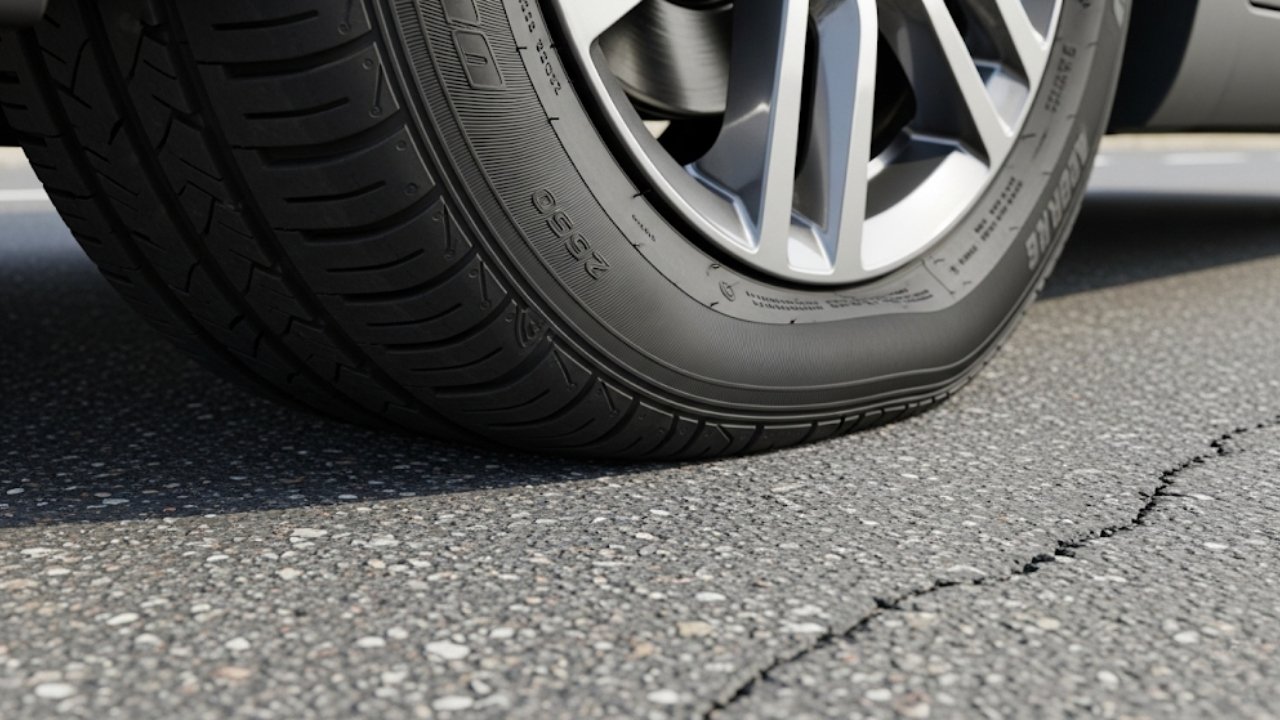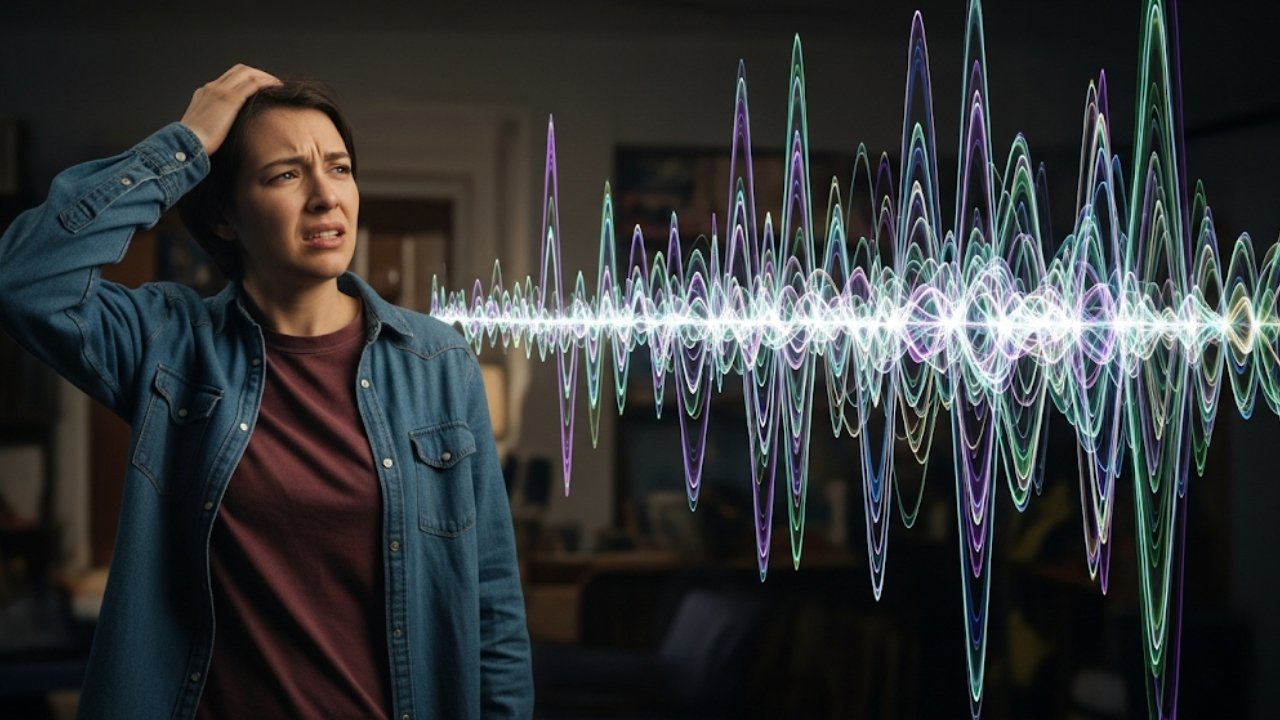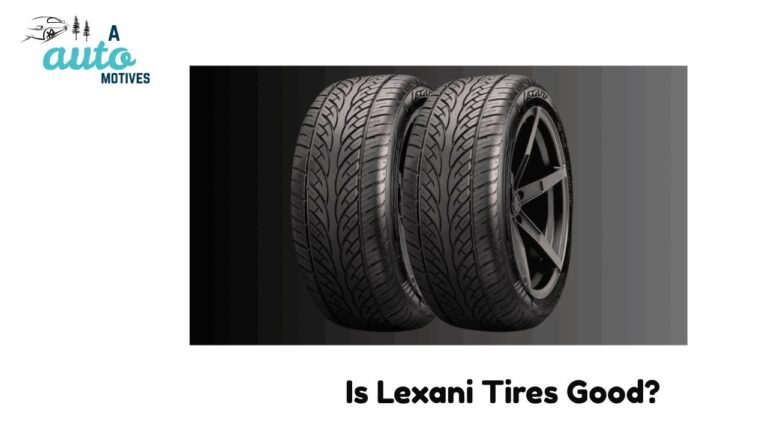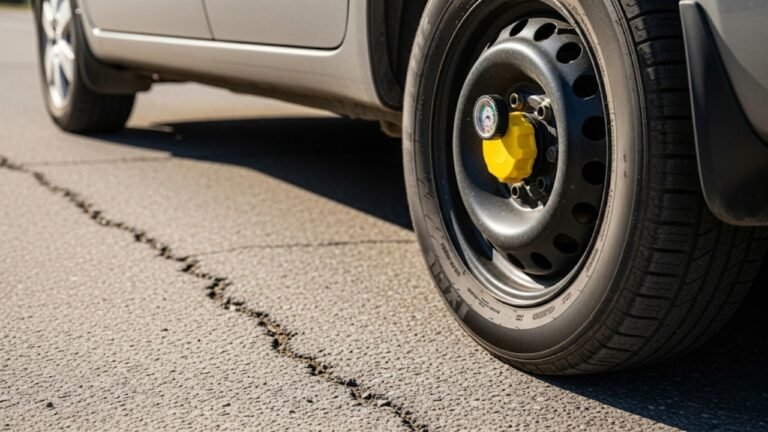Why Your Tire Sounds Flat But Isn’t?

We’ve all been there. You’re driving along, and suddenly you hear it — that weird, low whomp-whomp noise from your wheel. Or maybe it’s more like a hiss, like a soda can slowly leaking out. You pull over, expecting the worst. You check the tire. And… it looks perfectly fine.
Wait, what?
The tire sounds flat but isn’t. It’s not visibly low on air. The pressure gauge even says it’s within range. Yet something still feels off. That sound is real. But where’s it coming from?
This kind of mystery can drive anyone nuts. You start doubting your ears. You think maybe it’s just the road. Or maybe you’re imagining things?
Let’s break this down, step-by-step. This article dives deep into the tire sounds flat but isn’t dilemma, covering real causes, surprising fixes, and expert tips to help you solve the noise — once and for all.
The Sound That Plays Tricks on You

Later at the gas station, I checked all four tires. I even kicked them like an old-school mechanic. They were firm. No leaks. No visible damage. Yet the tire sounded flat but wasn’t. That led me to dig deeper — and what I found might surprise you.
Sometimes, that sound doesn’t mean a flat tire. It’s just your car talking in a different way.
Common Reasons Why a Tire Sounds Flat But Isn’t
Here’s the thing: your car is a complex machine, and sounds can be deceiving. There are several causes behind that phantom “flat tire” sound.
Let’s take a look at the most common culprits:
| Cause | Explanation |
|---|---|
| Uneven Road Surfaces | Grooved pavement or rough asphalt can mimic flat tire noise |
| Underinflated Tires (Not Flat) | Tire isn’t flat but is low enough to change the sound |
| Tire Tread Wear | Irregular tread can create whirring or droning sounds |
| Wheel Alignment Issues | Misalignment causes uneven tire pressure distribution |
| Wheel Bearing Wear | Bearings create grinding noises — sounds like a flat tire |
| Tire Separation | Internal tire damage that doesn’t always show on the outside |
| Debris Stuck in Tread | Rocks or objects can cause repetitive tapping or hissing sounds |
| Road Vibration Echo | The acoustics of your car’s cabin may amplify tire noise incorrectly |
Bullet Points to Watch For:
-
Tire pressure gauge shows normal, but the car feels different
-
You hear a low hum or soft flap that increases with speed
-
No visible damage, but there’s a persistent sound
-
You’ve rotated the tires recently or changed road surfaces
Sometimes the fix is super simple. Other times, it points to a bigger issue under the hood — or under the car.
Tire Tread and the Illusion of a Flat
Let’s talk about tire tread. This sneaky little feature does more than keep you from hydroplaning. If the tread wears unevenly, it can make your car sound off. The air moving through worn patches creates a rhythmic noise that can mimic a soft or flat tire.
Think of it like this — imagine running your finger across corduroy pants. That brushing sound? That’s similar to what worn tread can do at high speeds. Except now your car’s amplifying it.
If your tire sounds flat but isn’t, check the tread depth and wear pattern. Uneven tread can come from:
-
Skipping tire rotations
-
Aggressive driving
-
Poor wheel alignment
-
Sudden braking
Run your palm over the tire. Feel for bumps, waves, or flat spots. That “out-of-tune” feeling while driving might come from this — not an actual flat.
Tire Pressure: Not Too Low, But Not Right Either
Sometimes your tire isn’t flat — it’s just not fully inflated to optimal pressure. It’s like blowing up a balloon 90% of the way. It looks fine, but bounce it and it’s squishy. That’s how your car feels those minor pressure changes even if you don’t.
Let’s say your tire should be at 35 PSI, and it’s at 31. That seems close enough, right? But even a 3–4 PSI difference can change how the rubber hits the road. And the sound? Oh yes, it changes.
Here’s what to do:
-
Check your tire pressure when cold, not after a drive
-
Compare the PSI to the recommended number on the driver’s side door
-
Make adjustments — even small ones matter
If your tire sounds flat but isn’t, try inflating it just 2 PSI above your normal to test sound differences. It’s a quick, safe way to rule it out.
Could It Be Wheel Bearings?
If you’ve never heard of wheel bearings, don’t worry — you’re not alone. These are tiny metal balls that help your wheel spin smoothly. But when they wear out, they can create a low grinding or humming noise that mimics the sound of a deflating tire.
How to tell if it’s a bearing:
-
The sound gets louder when you turn
-
It changes with speed but not always with braking
-
It’s a deep, growling tone — not a high-pitched hiss
Bearings are tricky. You might hear the sound in one corner of the car, but it’s actually coming from another. That’s why many people think it’s a tire problem when it’s really the bearing whispering its warning.
If you’re hearing this and your tire sounds flat but isn’t, get it checked before it gets worse. A failing wheel bearing can eventually lead to a wheel detaching. Yep, not good.
The Psychology of Sound: Is Your Car Gaslighting You?
Let’s be honest — sometimes our brains mess with us. When we expect a flat tire, we hear one. That’s how powerful suggestion is. But cars have acoustic quirks too. Sound waves bounce differently inside your vehicle. The trunk acts like a drum. The wheel wells act like tunnels.
You hear the noise in the front, but it’s actually coming from the back. Or you swear the right tire is off, but it’s a rear-left issue.
This illusion is super common in cars like:
-
Sedans with large trunks
-
SUVs with poor soundproofing
-
Hatchbacks with exposed cargo areas
The fix? Drive with a friend and ask them where the sound is coming from. It’s like having a second opinion in your “car court.” Two ears are better than one — especially when diagnosing noises.
Internal Tire Damage: The Hidden Culprit
Sometimes, the scariest problems are the ones you can’t see. Your tire may look perfectly fine, but something inside could be failing. This is what mechanics refer to as internal tire separation.
What happens is this: the layers inside the tire — usually fabric or steel belts — begin to separate. This doesn’t always show up as a bubble or bulge. But as the separation worsens, it causes a thudding or flapping noise that mimics the sound of a flat tire.
You might feel:
-
A vibration that gets worse with speed
-
A sense that your car is “bouncing”
-
Slight pulling to one side
And of course, that sound — that strange, hollow “slap” with every rotation.
The frustrating part? It might pass a basic tire pressure and visual check. That’s why tire separation is often misdiagnosed until the tire fails completely. If you’re dealing with a tire that sounds flat but isn’t, and you’ve ruled out other causes, it might be time to have a tire shop inspect the inside layers with proper equipment.
Could It Just Be the Road?
Let’s not overthink it: the road itself might be fooling you.
I once drove across a bridge with a textured surface that sounded like all four tires were deflating. It was a heart-dropping noise. But once I hit regular pavement again? Silence.
Some roads have grooves, patches, or even rumble strips that create that air-release sound. It’s worse if your tires are wider or have aggressive tread patterns. They interact with the surface in weird ways.
You might hear:
-
A buzzing sound at higher speeds
-
A whooshing or hissing on concrete roads
-
Rhythmic tapping if joints or seams are present
If the tire sounds flat but isn’t, try this simple test: drive the same car on a different road surface. If the sound disappears, it was never your tire in the first place.
Tire Age and Rubber Fatigue
Rubber doesn’t age gracefully. Over time, even if your tires haven’t been used much, they start to lose elasticity. Tiny cracks form. The rubber stiffens. This aging process creates small changes in how the tire rolls, flexes, and — yes — sounds.
Here’s a metaphor: imagine an old pair of sneakers. They still look okay, but when you walk, they squeak and slap the ground differently than before. That’s what old tires do. They might still hold air and pass inspection, but they behave differently.
If your tire sounds flat but isn’t, check the sidewall for the DOT date code. If your tire is over 6 years old, it’s time to replace it — even if it looks fine.
Debris in the Tread: Small Thing, Big Noise
You’d be surprised how often rocks, nails, or small metal shards get stuck in your tread. They may not puncture your tire, but they cause a distinct tick-tick-tick as the tire rotates. On a quiet road, that sound can easily be mistaken for a slow leak or a flat.
Next time your tire sounds off:
-
Park the car in a quiet area.
-
Run your hand around the tire tread (carefully).
-
Remove any lodged debris.
Sometimes, it’s just a small pebble making a big fuss.
Brake Pad Contact and Suspension Squeaks
Here’s where it gets interesting: some sounds that we think come from the tires are actually from nearby systems, like the brakes or suspension. Worn brake pads can make a soft grinding that’s easily confused with a flat tire hiss.
Likewise, dry suspension parts — especially bushings and joints — can squeak and echo near the tires. These sounds are often more noticeable at lower speeds or when turning.
What to look out for:
-
Squeaking when going over bumps
-
Sound disappears when brakes are applied
-
Uneven tire wear due to suspension imbalance
If the tire sounds flat but isn’t, consider having a full brake and suspension check done.
Quick Troubleshooting Guide
Here’s a quick table to help you diagnose based on symptoms:
| Symptom | Possible Cause | Fix |
|---|---|---|
| Hissing noise at low speed | Road surface or minor leak | Check PSI, inspect road |
| Whump-whump sound at speed | Tire separation or low tread | Replace tire, inspect wear |
| Grinding or growling | Wheel bearing or brake pads | Mechanic inspection |
| Rhythmic ticking | Debris in tread | Remove debris |
| Hiss that fades at high speed | Underinflated tire | Adjust pressure |
Preventive Maintenance Tips
To prevent these sound-related mysteries in the future, here are some easy habits you can adopt:
-
Check tire pressure weekly — not just when it looks low
-
Rotate tires every 5,000 to 7,000 miles
-
Replace tires every 6 years, even with good tread
-
Listen carefully — sounds are early warning signs
-
Trust your instincts — if something sounds off, investigate
Remember, your car speaks in sounds. If your tire sounds flat but isn’t, that’s its way of asking for attention.
FAQs: Clearing Up Common Confusion
1. Why does my tire sound flat when it’s not?
The sound could be from underinflation, uneven tread wear, wheel bearings, or even road texture. Just because it sounds flat doesn’t mean it is.
2. Is it safe to drive if my tire sounds flat but isn’t?
It depends. If there’s no vibration or warning light, it’s likely safe short-term. But it’s best to inspect the tires or get a professional opinion to rule out hidden issues.
3. Can wheel alignment affect tire noise?
Absolutely. Poor alignment causes uneven wear, which leads to strange noises that can mimic a flat tire sound.
4. Will adding more air help if the tire sounds flat?
Sometimes. If the pressure is slightly low, adding a few PSI might eliminate the noise. Just don’t overinflate beyond the manufacturer’s recommended PSI.
5. What’s the easiest way to know if it’s a tire issue or something else?
Drive at different speeds and on different road surfaces. If the sound changes drastically, it’s more likely road or suspension-related than an actual tire problem.
Final Thoughts: Trust Your Ears, But Also Your Eyes
When your tire sounds flat but isn’t, it’s not just annoying — it’s confusing. And let’s be real: none of us want to play car whisperer every time we hear a new sound.
But paying attention to the details can save you from bigger issues. Start with the basics — check pressure, inspect tread, and listen closely. If you’re still not sure, get a mechanic to weigh in. Sometimes a second set of ears is all it takes.
After all, your car is like a friend. It doesn’t lie — but sometimes, it speaks in riddles.




